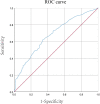Which Factors Are Associated With Reproductive Outcomes of DOR Patients in ART Cycles: An Eight-Year Retrospective Study
- PMID: 35813637
- PMCID: PMC9259947
- DOI: 10.3389/fendo.2022.796199
Which Factors Are Associated With Reproductive Outcomes of DOR Patients in ART Cycles: An Eight-Year Retrospective Study
Abstract
Introduction: Women with diminished ovarian reserve (DOR) have a lower pregnancy rate and higher cancellation rate compared to those without DOR when seeking assisted reproductive technology. However, which factors are associated with reproductive outcomes and whether AMH is a predictor of clinical pregnancy remain unclear.
Objective: This retrospective study was designed to find factors associated with reproductive outcomes in DOR patients and then discuss the role of AMH in predicting cycle results among this population.
Method: A total of 900 women were included in the study. They were diagnosed with DOR with the following criteria: (i) FSH > 10 IU/L; (ii)AMH < 1.1 ng/ml; and (iii) AFC <7. They were divided into different groups: firstly, based on whether they were clinically pregnant or not, pregnant group vs. non-pregnant group (comparison 1); secondly, if patients had transferrable embryos (TE) or not, TE vs. no TE group (comparison 2); thirdly, patients undergoing embryo transfer (ET) cycles were divided into pregnant I and non-pregnant I group (comparison 3). The baseline and ovarian stimulation characteristics of these women in their first IVF/ICSI cycles were analyzed. Logistic regression was performed to find factors associated with clinical pregnancy.
Results: Of the 900 DOR patients, 138 women got pregnant in their first IVF/ICSI cycles while the rest did not. AMH was an independent predictor of TE after adjusting for confounding factors (adjusted OR:11.848, 95% CI: 6.21-22.62, P< 0.001). Further ROC (receiver operating characteristic) analysis was performed and the corresponding AUC (the area under the curve) was 0.679 (95% CI: 0.639-0.72, P< 0.001). Notably, an AMH level of 0.355 had a sensitivity of 62.6% and specificity of 65.6%. However, there was no statistical difference in AMH level in comparison 3, and multivariate logistic regression showed female age was associated with clinical pregnancy in ET cycles and women who were under 35 years old were more likely to be pregnant compared to those older than 40 years old (adjusted OR:4.755, 95% CI: 2.81-8.04, P< 0.001).
Conclusion: AMH is highly related to oocyte collection rate and TE rate,and 0.355 ng/ml was a cutoff value for the prediction of TE. For DOR patients who had an embryo transferred, AMH is not associated with clinical pregnancy while female age is an independent risk factor for it.
Keywords: AMH (anti-Müllerian hormone); DOR (diminished ovarian reserve); IVF in vitro fertilization; antral follicle count (AFC); reproductive outcomes.
Copyright © 2022 Li, Sun, Wang, Zhang and Sun.
Conflict of interest statement
The authors declare that the research was conducted in the absence of any commercial or financial relationships that could be construed as a potential conflict of interest.
Figures
Similar articles
-
Identify high-risk DOR women ≤ 35 years old following assisted reproduction technology through cutoffs of anti-mullerian hormone and antral follicle counts.Reprod Biol Endocrinol. 2024 Oct 25;22(1):130. doi: 10.1186/s12958-024-01298-4. Reprod Biol Endocrinol. 2024. PMID: 39456075 Free PMC article.
-
AMH has no role in predicting oocyte quality in women with advanced age undergoing IVF/ICSI cycles.Sci Rep. 2020 Nov 12;10(1):19750. doi: 10.1038/s41598-020-76543-y. Sci Rep. 2020. PMID: 33184364 Free PMC article.
-
Predictive value of anti-Mullerian hormone for pregnancy outcomes following assisted reproductive techniques (ART) in Southwest China.Reprod Health. 2022 Dec 13;19(1):224. doi: 10.1186/s12978-022-01524-5. Reprod Health. 2022. PMID: 36514055 Free PMC article.
-
Is diminished ovarian reserve a risk factor for miscarriage? Results of a systematic review and meta-analysis.Hum Reprod Update. 2021 Oct 18;27(6):973-988. doi: 10.1093/humupd/dmab018. Hum Reprod Update. 2021. PMID: 34254138
-
Does an association exist between menstrual cycle length within the normal range and ovarian reserve biomarkers during the reproductive years? A systematic review and meta-analysis.Hum Reprod Update. 2020 Nov 1;26(6):904-928. doi: 10.1093/humupd/dmaa013. Hum Reprod Update. 2020. PMID: 32514566
Cited by
-
Clinical pregnancy outcomes in young women with diminished ovarian reserve undergoing frozen embryo transfer: a comprehensive analysis with exploratory insights into endometrial aging.Front Endocrinol (Lausanne). 2025 Jul 29;16:1608200. doi: 10.3389/fendo.2025.1608200. eCollection 2025. Front Endocrinol (Lausanne). 2025. PMID: 40801036 Free PMC article.
-
Chitosan alleviates ovarian aging by enhancing macrophage phagocyte-mediated tissue homeostasis.Immun Ageing. 2024 Jan 27;21(1):10. doi: 10.1186/s12979-024-00412-9. Immun Ageing. 2024. PMID: 38279177 Free PMC article.
-
Role of epigenetic regulation in diminished ovarian reserve.J Assist Reprod Genet. 2025 Feb;42(2):389-403. doi: 10.1007/s10815-024-03301-8. Epub 2024 Dec 7. J Assist Reprod Genet. 2025. PMID: 39644448 Free PMC article. Review.
-
Ovarian sensitivity index-based nomogram for predicting clinical pregnancy outcomes in patients with diminished ovarian reserve undergoing in vitro fertilization or intracytoplasmic sperm injection.Front Med (Lausanne). 2025 Jun 27;12:1618552. doi: 10.3389/fmed.2025.1618552. eCollection 2025. Front Med (Lausanne). 2025. PMID: 40655108 Free PMC article.
-
Drug-free in vitro activation and autologous transplantation in infertile women with diminished ovarian reserve: An experimental pilot study.Int J Reprod Biomed. 2024 Aug 5;22(6):425-432. doi: 10.18502/ijrm.v22i6.16792. eCollection 2024 Jun. Int J Reprod Biomed. 2024. PMID: 39205924 Free PMC article.
References
Publication types
MeSH terms
Substances
LinkOut - more resources
Full Text Sources



